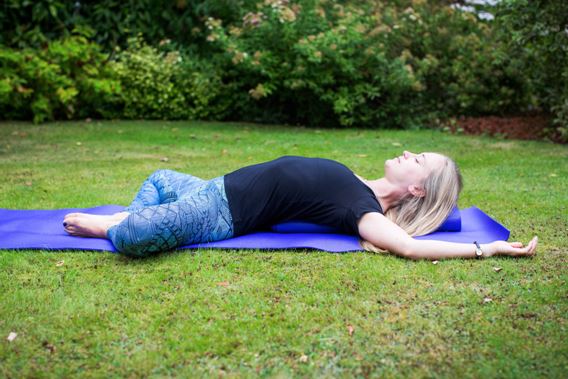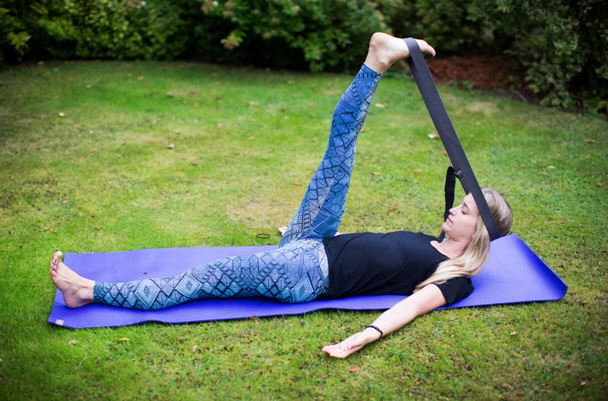We’ve all been in a place in our lives when we’ve felt a bit anxious. Speaking in front of large groups people or performing on stage, whatever it maybe, that familiar rush of adrenaline is totally normal, and quite often (believe it or not!) helpful. However, when anxiety becomes excessive, it is a disabling condition.
Whilst medication may help you deal with these feelings to a certain extent, fundamental changes need to be made to your life for long lasting freedom from anxiety. According to traditional Chinese medical theory, emotional stress and anxiety particularly involves the kidneys and heart. So from a Chinese Medicine and Yoga perspective, here are 3 simple tips that you can implement into your life to support the re-balancing of each of these organs to help deal with anxiety:
1 – Supported Supta Badhakonasana with arm variation – Heart

Holding a pose, such as Supta Badha Konasana is an effective way to soften feelings of anxiety by rebalancing the Heart/ Fire element. Roll up your Yoga mat until it’s diameter is between 3-4 inches. Lie back onto the rolled up mat so it supports the length of your spine and your shoulder blades can rest on either side of the mat. At this point, you may need to adjust the diameter to make sure it is comfortable for you. Make sure that the mat supports your head. Bend your knees and let them fall out to the side while you bring the soles of your feet together into Badha Konasana. Place your arms into ‘cactus’, making sure that your elbows are at the same height or higher than your shoulders. Practice this pose in the morning or evening every day and stay for 3-5 minutes paying close attention to your breath by seeing if you can make your exhalation longer than your inhalation.
2 – Supta Padangustasana – Kidneys

Practicing Supta Padangustasana is an effective way to ease anxiety by rebalancing the Kidney/ Water element. If you have a Yoga strap, make a big loop and start of by hooking the strap around the middle portion of back of your head. Raise one leg up and hook the other end of the strap around the sole of your foot. Hold onto the strap with your hands on either side (avoid bunching the strap together in the middle). If you do not have a strap, simply raise your leg and hold onto the back of the thigh/ calf or foot (if this is reasonable!) You will be holding this pose for several minutes so refrain from pushing yourself into your deepest variation of this pose. You want it to be relaxing so if you find that your leg starts starting, just ease of slightly so that you can find a softness in the pose. It is natural for your shoulders to raise slightly away from the ground but your aim here is to let them to fall back towards the mat. As before, practice this pose daily and hold for between 3-5 minutes paying close attention to your breathing through your nose, noticing the cool air as you breath in and the warm air as you breath out. If you mind wanders, simply bring it back to the quality of your breath and the sensations that you have around your nose.
3 – Meditation
With anxiety is a good idea to keep your meditation practice simple and with very specific guideline. The structure of having a protocol will help ease feelings of stress. A good example of this would be counting the breath for 5 minutes when you wake up in the morning or go to sleep at night. Find a comfortable seat on a cushion so that your hips are slightly raised above your knees. Sit up tall and rest the palms of your hands on your knees. Let your shoulders be soft and allow your elbows to hang directly below your shoulders. Close your eyes and begin by just noticing the quality of your breath as your breathe in and out through your nose. After a few breaths, start counting: 5 counts for your inhale, 5 counts for your exhale. Continue this for 5 minutes (you can always set an alarm to remind you when to stop). An additional 1-2 minutes can be practiced as needed throughout the day.
Routine is fundamental to easing anxiety. Whether it is waking up each morning and meditating or going for a run, both your body and your mind will benefit from this clear structure. So often, we have these unrealistic expectations of ourselves, which when we don’t reach, induce both stress and anxiety. So keep it short and simple and build up your routine over time. Making just one small change that you continue everyday will have a greater impact then practicing everything in excess once a month. With all 3 of the suggestions: Supta Badhakonasana, Supta Padangustasana and meditation, just make a plan to introduce these into your daily routine gradually. Decide on a time of day that works best for you on a daily basis. It is important that you keep to your routine by practicing at the same time each day. Perhaps you start off by just doing each pose for a minute each day – that is great! Just get into the habit and build up the time to make it realistic for you.
Alice Louise Yoga is a Yoga Medicine teacher and assistant to Tiffany Cruikshank. She is currently working towards her 500 hours and 1000 hour Advanced Teacher Training with Yoga Medicine.
You can find her at: www.alicelouiseyoga.com
Instagram: @alicelouiseyoga
Twitter: @alicelouiseyoga
Facebook: Alice Louise Yoga
